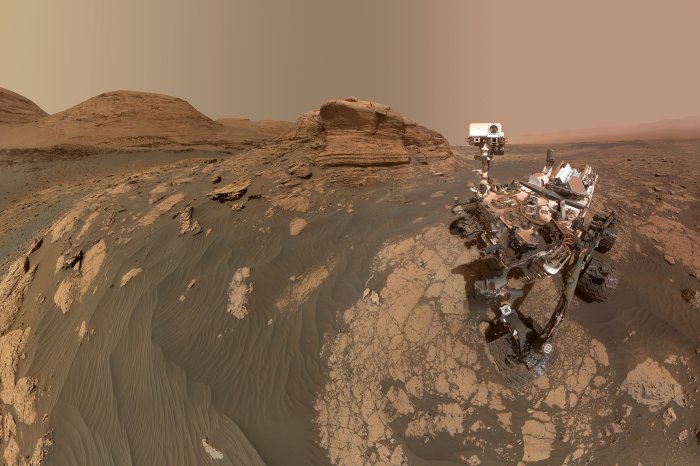NASA's Curiosity Mars rover is pictured reaching down to drill into a rock target called "Buckskin." The MAHLI camera on Curiosity's robotic arm took multiple images on Aug. 5, 2015, that were stitched together into this selfie. File Photo courtesy of NASA/JPL-Caltech/MSSS |
License Photo
July 25 (UPI) -- A chunk of the "extremely rare" mineral tridymite unexpectedly found at the bottom of Gale Crater on Mars may have been created by a volcanic eruption more than three billion years ago, researchers said Monday.
The discovery of tridymite, a high-temperature and low-pressure form of quartz, perplexed scientists when it was discovered by NASA's Curiosity rover in 2016 because the mineral is normally associated with volcanic activity on Earth where it is already considered very rare.
The research, published online in Earth and Planetary Science Letters, agreed with a previous study from 2016 that found that a "silicic volcanism scenario" was likely responsible for the creation of the tridymite.
The new study further added thermodynamical models explaining how tridymite is a "reasonable product" of evolution of the same magmatic processes that produced other rocks in the Gale Crater.
"There's ample evidence of basaltic volcanic eruptions on Mars, but this is a more evolved chemistry," study co-author Kirsten Siebach said in a press release.
"This work suggests that Mars may have a more complex and intriguing volcanic history than we would have imagined before Curiosity," said Siebach, a mission specialist on NASA's Curiosity team and assistant professor at Rice University.
Gale Crater, where the sample was taken, had been selected as the landing site for the rover because of the likelihood it once contained liquid water.
The tridymite was discovered in a larger rock sample taken from lake-formed mudstone that also contained feldspar, cristobalite and opaline silica.
"The discovery of tridymite in a mudstone in Gale Crater is one of the most surprising observations that the Curiosity rover has made in 10 years of exploring Mars," Siebach said.
"Tridymite is usually associated with quartz-forming, explosive, evolved volcanic systems on Earth, but we found it in the bottom of an ancient lake on Mars, where most of the volcanoes are very primitive."
Siebach and her colleagues compared data from the Martian rock with every reported find of tridymite on Earth and reexamined sedimentary evidence from the lake in Gale Crater to develop a scenario for how the mineral formed.
"Martian magma sat for longer than usual in a chamber below a volcano, undergoing a process of partial cooling called fractional crystallization until extra silicon was available," the researchers said.
"In a massive eruption, the volcano spewed ash containing the extra silicon in the form of tridymite into the Gale Crater lake and surrounding rivers. Water helped break down the ash through natural processes of chemical weathering, and water also helped sort the minerals produced by weathering."
The scenario would account for the concentrated tridymite, as well as explain the presence of the opaline silicates and reduced concentrations of aluminum oxide.
"It's actually a straightforward evolution of other volcanic rocks we found in the crater," Siebach said.
"We argue that because we only saw this mineral once, and it was highly concentrated in a single layer, the volcano probably erupted at the same time the lake was there. Although the specific sample we analyzed was not exclusively volcanic ash, it was ash that had been weathered and sorted by water."
NASA’s Curiosity Mars rover used two different cameras to create this panoramic selfie, comprised of 60 images, in front of Mont Mercou, a rock outcrop that stands 20 feet tall on March 26, 2021, the 3,070th Martian day, or sol, of the mission. These were combined with 11 images taken by the Mastcam on the mast, or "head," of the rover on March 16. The hole visible to the left of the rover is where its robotic drill sampled a rock nicknamed "Nontron." The Curiosity team is nicknaming features in this part of Mars using names from the region around the village of Nontron in southwestern France. Photo courtesy of NASA/JPL-Caltech/MSSS
















